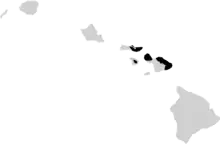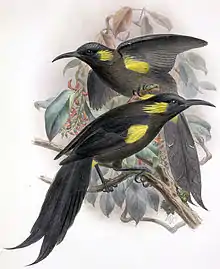Bishop's ʻōʻō
The Bishop's ‘ō‘ō or Molokai ‘ō‘ō (Moho bishopi) was the penultimate member of the extinct genus of the ‘ō‘ōs (Moho) within the extinct family Mohoidae. It was previously regarded as member of the Australo-Pacific honeyeaters (Meliphagidae).[2] Lionel Walter Rothschild named it after Charles Reed Bishop, the founder of the Bishop Museum.
| Bishop's ‘ō‘ō | |
|---|---|
%252C_Bishop_Museum%252C_Honolulu.jpg.webp) | |
| Specimen in Bishop Museum, Honolulu | |
| Scientific classification | |
| Domain: | Eukaryota |
| Kingdom: | Animalia |
| Phylum: | Chordata |
| Clade: | Dinosauria |
| Class: | Aves |
| Order: | Passeriformes |
| Family: | †Mohoidae |
| Genus: | †Moho |
| Species: | †M. bishopi |
| Binomial name | |
| †Moho bishopi (Rothschild, 1893) | |
 | |
| Synonyms | |
| |
Description

It was discovered in 1892 by Henry C. Palmer, a bird collector for Lord Rothschild. Its length was about 29 centimeters. The tail had reached a length of 10 centimeters. The plumage was general glossy black with yellow feather tufts on the maxillaries, beneath the wings and the undertail coverts. Their songs were simple two notes, took-took, which could be heard for miles.
Distribution
It was endemic to the montane forests of the Hawaiian islands of Molokai, Maui, and Lanai. Subfossil bone finds from Maui (on Mount Olinda at about 4,500 ft above sea level) are sometimes referred to in literature as the Maui ʻōʻō.[3]
Ecology
Little is known about its ecology. It fed on nectar from the flowers of Hawaiian lobelioids, much like other members of its family.
Extinction
Causes of the bird's extinction include deforestation, predation by introduced predators (such as the black rat), clearing of land for agriculture and livestock grazing, and diseases which were introduced by mosquitoes. It was last seen in 1904 by ornithologist George Campbell Munro. In 1915, Munro tried to verify reports of eventual sightings but he never found live individuals again.
Purported Maui Sightings
Reports of an O'o on Maui have been catalogued since 1828.[4] In 1902, Henshaw reported seeing a bird matching the appearance of Bishop's O'o in the Olinda region. A spat of sightings of a bird with field marks and calls matching Bishop's O'o was reported in the 1980's from the Ko'olau Nature Reserve, most notably by Stephen R. Sabo in 1981.[5] However, no specimen was ever captured or photographed in this region to confirm these reports. Subfossil remains of an O'o are known from Maui, so it is not implausible Bishop's O'o may have occurred here and evaded detection due to Maui being overlooked by 19th and 20th century collectors.[6]
Specimens
Today the bird can only be seen as specimens, paintings, picture notes, and skins. Records of these types are known to be held in Bremen, Cambridge, Massachusetts;. Honolulu; London; Molokai, Hawaiian Islands; New York; and Stockholm.
See also
- Mo-Ho-Bish-O-Pi - a Welsh indie rock group named in honor of the bird.
References
- BirdLife International (2016). "Moho bishopi". IUCN Red List of Threatened Species. 2016: e.T22704335A93963979. doi:10.2305/IUCN.UK.2016-3.RLTS.T22704335A93963979.en. Retrieved 12 November 2021.
- Fleischer R.C., James H.F., and Olson S.L. (2008). Convergent Evolution of Hawaiian and Australo-Pacific Honeyeaters from Distant Songbird Ancestors. Current Biology, Volume 18, Issue 24, 1927-1931, 11 December 2008.
- Walther, Michael; Hume, Julian P. (2016). Extinct birds of Hawaii. Mutual Pub.
- Scott, J. Michael; Mountainspring, Stephen; Ramsey, Fred L.; Kepler, Cameron B. (29 August 1986). Forest Bird Communities of the Hawaiian Islands: Their Dynamics, Ecology, and Conservation. Cooper Ornithological society. p. 106.
- Sabo, Stephen R. (1982). "The Rediscovery of Bishop's O'o on Maui". ʻElepaio. 42.
- Sabo, Stephen R. (1982). "The Rediscovery of Bishop's O'o on Maui". ʻElepaio. 42.
Further reading
- Munro, George C. (1944 and its revised 2nd. edition from 1960): Birds of Hawaii
- Flannery, Tim & Schouten, Peter (2001): A Gap in Nature
- Fuller, Errol (2000): Extinct Birds
- Day, David (1981): The Doomsday Book of Animals
- Greenway, James C. (1967): Extinct and Vanishing Birds of the World
- Luther, Dieter (2005): Die ausgestorbenen Vögel der Welt
External links
- Fact Sheets Bishops Oo
- Species factsheet - BirdLife International
